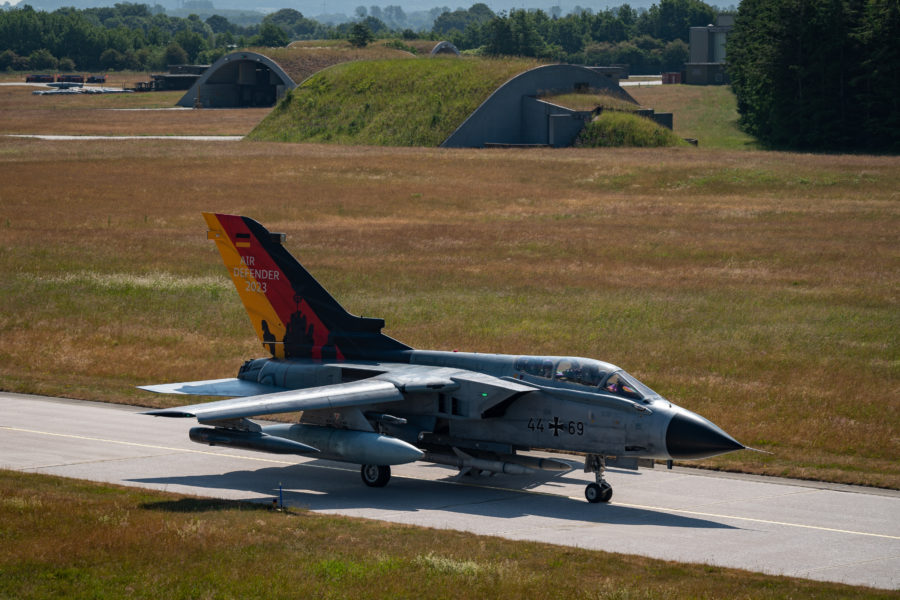The OCCASUS alliance, composed of the Eastern nations of Murinus, Plumbeus, Griseus, and Cinereus, have invaded Germany, and are “trying to push north to the Baltic Sea,” the German military, or Bundeswehr, said in a release. To do so, the alliance is relying on a mix of sabotage operations and special forces supported from by airpower. In response, NATO has triggered Article V, calling for the collective defense of Germany.
All of this is fictional. But it is the premise of Air Defender 23, a massive air exercise led by Germany and taking place across Europe that kicked off June 12. All told, 25 nations are participating in the nearly two-week exercise.
The exercise has been years in the planning—well before the full-scale invasion of Ukraine ordered by Russian President Vladimir Putin in February 2022. But the need for NATO to bolster its military might is clear to its members, whose defense ministers will gather later this week in Brussels. Germany has pledged a dramatic change in defense policy and increased spending. NATO has reinforced its eastern flank. Air Defender will test out the alliance’s ability to defend itself with airpower.
All told, some 10,000 personnel and 250 aircraft from NATO nations and Japan are participating. Nearly 100 aircraft of those aircraft are American, almost all from the Air National Guard.
According to the ANG, Air Defender is “NATO’s largest airpower exercise since its inception.”
More than 40 Guard units are participating. Their aircraft include F-35s, F-15s, F-16s, A-10s, MQ-9s, C-130s, KC-135s, C-17s, and KC-46s. Active-Duty F-16s from Spangdahlem Air Base, Germany, will also join in. European air forces are bringing fighters and other aircraft such as Eurofighters, Tornados, Gripens, and American-made export model F-16s and F-18s.
Because the exercise focuses on a threat from the east and a combined response, aircraft are also operating from forward locations in the Czech Republic and the eastern flank countries of Estonia and Latvia.
The German and U.S. militaries say the exercise encompasses far more than aircraft flying together, but real-world simulated combat, as officials previously detailed to Air & Space Forces Magazine. The scale is large enough that some portions of German airspace will close to civilian aircraft temporarily.
But airpower isn’t the only factor in Air Defender as “the conflict in the imagined scenario is far more complex, also encompassing the political, economic and media levels,” the Bundeswehr says. “The core of the large-scale exercise is to test the military’s ability to react and act in the air in a resilient manner and to be able to protect the population from medium-range missiles, for example.”
“I would be pretty surprised if any world leader was not taking note of what this shows, in terms of the spirit of this alliance, which means the strength of this alliance,” Amy Gutmann, the U.S. ambassador to Germany, told reporters. “That includes Mr. Putin.”
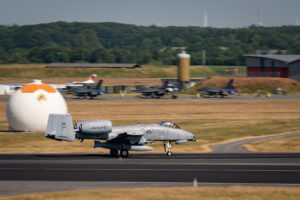
A U.S. Air Force A-10C Thunderbolt II aircraft assigned to the 127th Wing, Michigan National Guard, takes off at Jagel Airfield, Germany, on the kickoff day of exercise Air Defender 2023 (AD23), June 9, 2023. There are 24 varying types of aircraft among the approximately 250 participating aircraft, with nearly 100 of these aircraft assigned to more than 40 Air National Guard units—marking AD23 as the largest air forces deployment exercise since NATO was founded. (U.S. Air National Guard photo by Tech. Sgt. Sarah M. McClanahan) 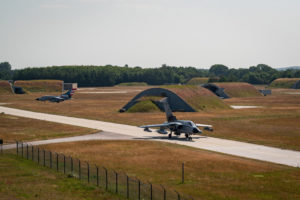
German Panavia Tornado aircraft taxi down the flight line at Jagel Airfield, Germany, on the kickoff day of exercise Air Defender 2023 (AD23), June 9, 2023. Exercise AD23 is a German-led, multinational exercise focusing on operational and tactical-level field training, primarily held in Germany, with forward operating locations in the Czech Republic, Estonia and Latvia. (U.S. Air National Guard photo by Tech. Sgt. Sarah M. McClanahan)

A Hungarian Saab JAS-39C Gripen aircraft takes off at Jagel Airfield, Germany, on the kickoff day of exercise Air Defender 2023 (AD23), June 9, 2023. Exercise AD23 is a German-led, multinational exercise focusing on operational and tactical-level field training, primarily held in Germany, with forward operating locations in the Czech Republic, Estonia and Latvia. (U.S. Air National Guard photo by Tech. Sgt. Sarah M. McClanahan)
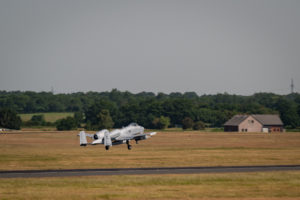
A U.S. Air Force A-10C Thunderbolt II aircraft assigned to the 127th Wing, Michigan National Guard, takes off at Jagel Airfield, Germany, on the kickoff day of exercise Air Defender 2023 (AD23), June 9, 2023. There are 24 varying types of aircraft among the approximately 250 participating aircraft, with nearly 100 of these aircraft assigned to more than 40 Air National Guard units—marking AD23 as the largest air forces deployment exercise since NATO was founded. (U.S. Air National Guard photo by Tech. Sgt. Sarah M. McClanahan)
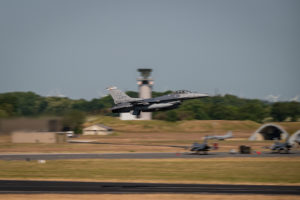
A U.S. Air Force F-16C+ Fighting Falcon aircraft assigned to the 140th Wing, Colorado National Guard, takes off at Jagel Airfield, Germany, on the kickoff day of exercise Air Defender 2023 (AD23), June 9, 2023. Exercise AD23 is a German-led, multinational exercise focusing on operational and tactical-level field training, primarily held in Germany, with forward operating locations in the Czech Republic, Estonia and Latvia. (U.S. Air National Guard photo by Tech. Sgt. Sarah M. McClanahan)
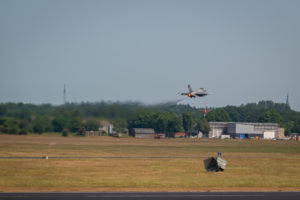
A U.S. Air Force F-16C/D Fighting Falcon aircraft assigned to the 114th Fighter Wing, South Dakota National Guard, takes off at Jagel Airfield, Germany, on the kickoff day of exercise Air Defender 2023 (AD23), June 9, 2023. There are 24 varying types of aircraft among the approximately 250 participating aircraft, with nearly 100 of these aircraft assigned to more than 40 Air National Guard units—marking AD23 as the largest air forces deployment exercise since NATO was founded. (U.S. Air National Guard photo by Tech. Sgt. Sarah M. McClanahan)
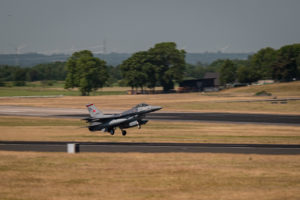
A Turkish F-16 Fighting Falcon aircraft takes off at Jagel Airfield, Germany, on the kickoff day of exercise Air Defender 2023 (AD23), June 9, 2023. There are 24 varying types of aircraft among the approximately 250 participating aircraft, with nearly 100 of these aircraft assigned to more than 40 Air National Guard units—marking AD23 as the largest air forces deployment exercise since NATO was founded. (U.S. Air National Guard photo by Tech. Sgt. Sarah M. McClanahan)
